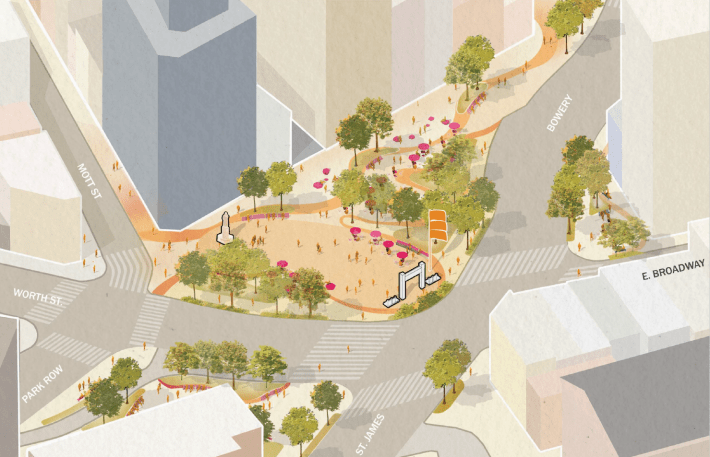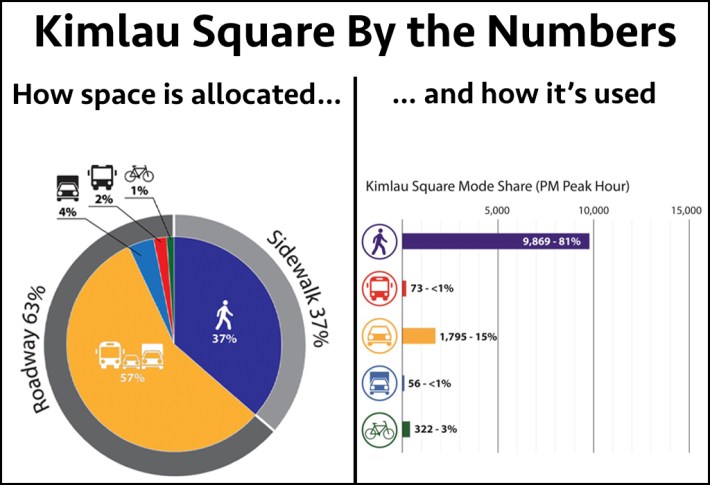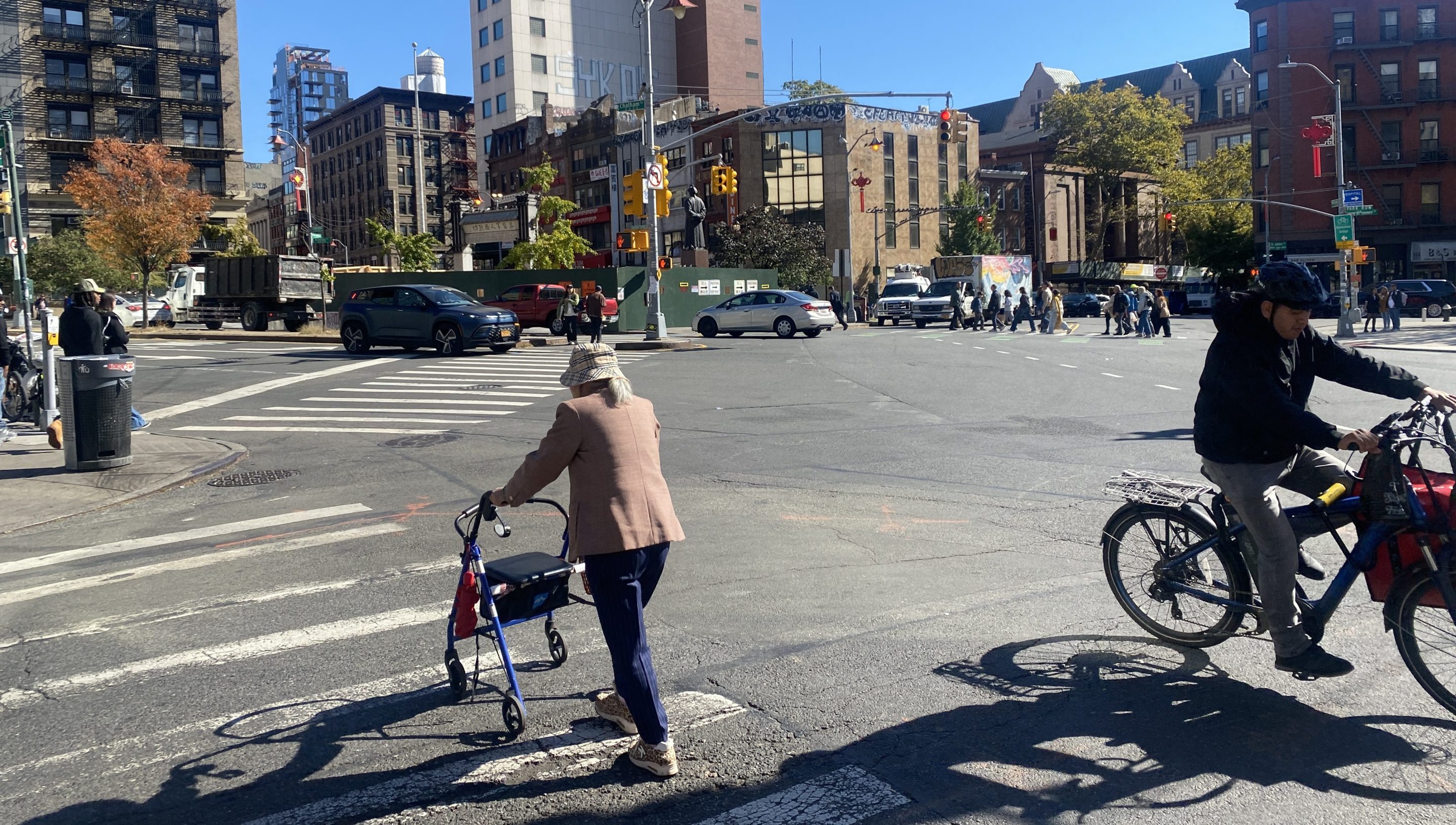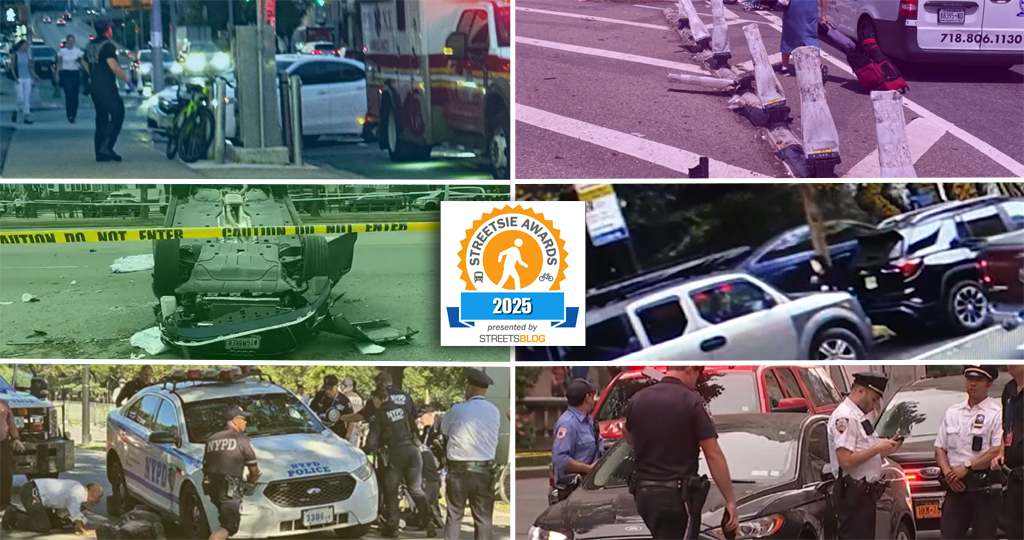The city's plans to overhaul Kimlau Square in Chinatown reclaims more streetscape from cars for people, but residents urged officials to think bigger in an area that is predominantly pedestrian.
The redesign unveiled on Tuesday would flip the plaza from the east to the west side of the Bowery, near Worth Street, and straighten out the seven-way intersection around it.
But locals said the $55-million overhaul still leaves too much space for private automobiles, despite foot traffic accounting for almost all people passing through the area.
"The redesign is beginning to do a good job in terms of looking at how people move through the square," said Francesco Galetto, a resident of nearby Chatham Towers. [But] why do we need six lanes of traffic, three coming in and three coming out?"
The Adams administration released a fresh set of renderings, though construction is not set to start until 2027, well into the next mayor's term.

Adams first announced the proposal last year, and it is a revival of a Bloomberg-era redesign that never took off. The older version also included a more ambitious build-out of the largely car-free Park Row with a pedestrian ramp connecting up to NYPD headquarters at One Police Plaza.
Eight-in-10 people passing through Kimlau Square at rush hour are pedestrians – nearly 10,000 people – but they get only about one-third of the streetscape, according to the Department of Transportation.
Pedestrians have to cross wide roads feeding car traffic around Lower Manhattan, which is especially challenging for the neighborhood's disproportionately elderly population.

Chinatown residents tend to be older, poorer and have fewer cars than Manhattan and New York City as a whole, with a mere 14 percent of households owning a motor vehicle, compared to 23 percent in the borough and 45 percent citywide.
"Most of the residents and people who come to Chinatown do not own cars, they’re not privileged enough to use Ubers for every single one of their trips. They rely on walking, they rely on public transportation," said Nancy Kong, another resident.
DOT's proposal rights some of the wrongs by more than doubling the walkable part of the square from about 11,250 square feet to 27,700 square feet, while extending the curb on corners to shorten pedestrian crossing distances. That shifts the share of pedestrian space to just over half.

But the agency should also widen the neighborhood's insufficient sidewalks, and work with state transit officials to provide more bus service, which could boost the area's businesses, according to Kong.
"This is what will help the economy of Chinatown, it’s the foot traffic, it’s not the cars," she said.
"Our community has been asking the gov and mayor for investments in Chinatown — this is nearly $56 million of committed funding," Kong added. "We have to make the most of it and make it work for us — safety and economic revitalization should be the priorities for everyone."
Chinatown's car-free corridors embracing outdoor dining like Pell and Doyers streets fared far better than their car-friendly neighbors during the pandemic, according to a DOT report, and business has been booming on similar setups on Canal Street.
The city could also restrict some of the arteries to one-way traffic instead of two, Galetto said.
"One of the simple ways to alleviate traffic congestion would be redesigning the ways the streets flow, so you don’t have two-way intersections at every intersection along the way," said the Manhattanite. "It’s about getting people safely across, and right now it’s a disaster, both as a driver and a pedestrian."
Adjacent Park Row, for example, has been closed to private car traffic since 9/11, due to security concerns of allowing drivers too close to police headquarters.
Some car-first groups and politicians in the area have long been pushing mayoral administrations from Bloomberg to Adams to reopen Park Row to cars, and the latter almost took the bait, before deciding to keep the restriction. That allowed DOT to give the Checkpoint Charlie-style area a more welcoming facelift.
The redesign aligns Kimlau Square more closely with Park Row, which could boost the number of people coming into the area, especially the many tourists wandering off the Brooklyn Bridge's walkway.
"There’s a higher likelihood that the pedestrian-friendly design would trickle down to Park Row," said Jason Lee, an architecture professor at the Pratt Institute who lives at nearby Chatham Towers.
The agency recently unveiled changes on nearby Canal Street to expand the footprint of pedestrian and bike infrastructure which, similarly, provide a solid start but leave room for improvement.
Lee said the upgrades could transform the car-focused intersection into a community amenity, similar to the neighborhood's gathering hotspot of Columbus Park.
"You want a sense of liveliness, of senior citizens being comfortable to hang out, while there’s enough space for gatherings," Lee said.
DOT spokesperson Vin Barone said the agency looks forward "to gathering feedback from local residents and completing a redesign of this intersection that will better serve the high number of pedestrians by shortening street crossing distances, dramatically expanding pedestrian space, and reducing the number of turning vehicles.”






